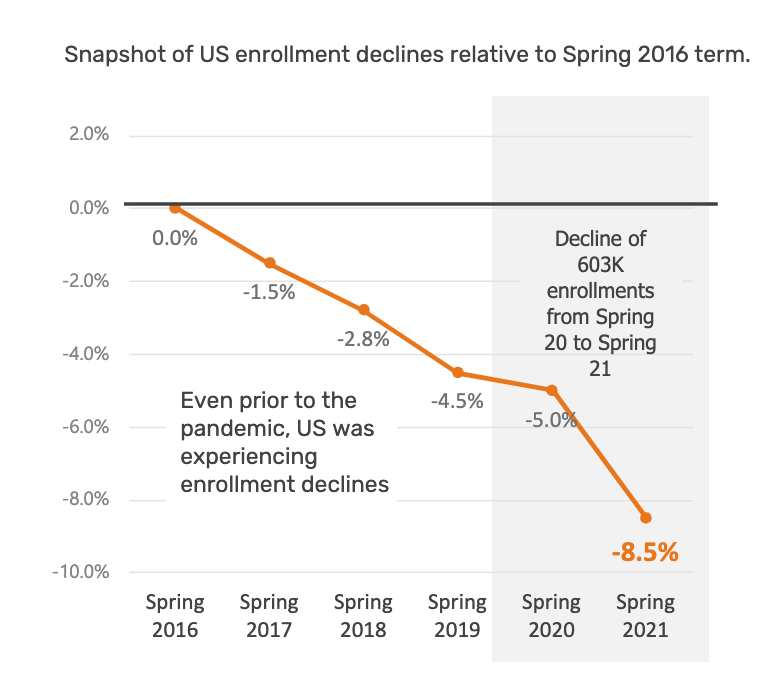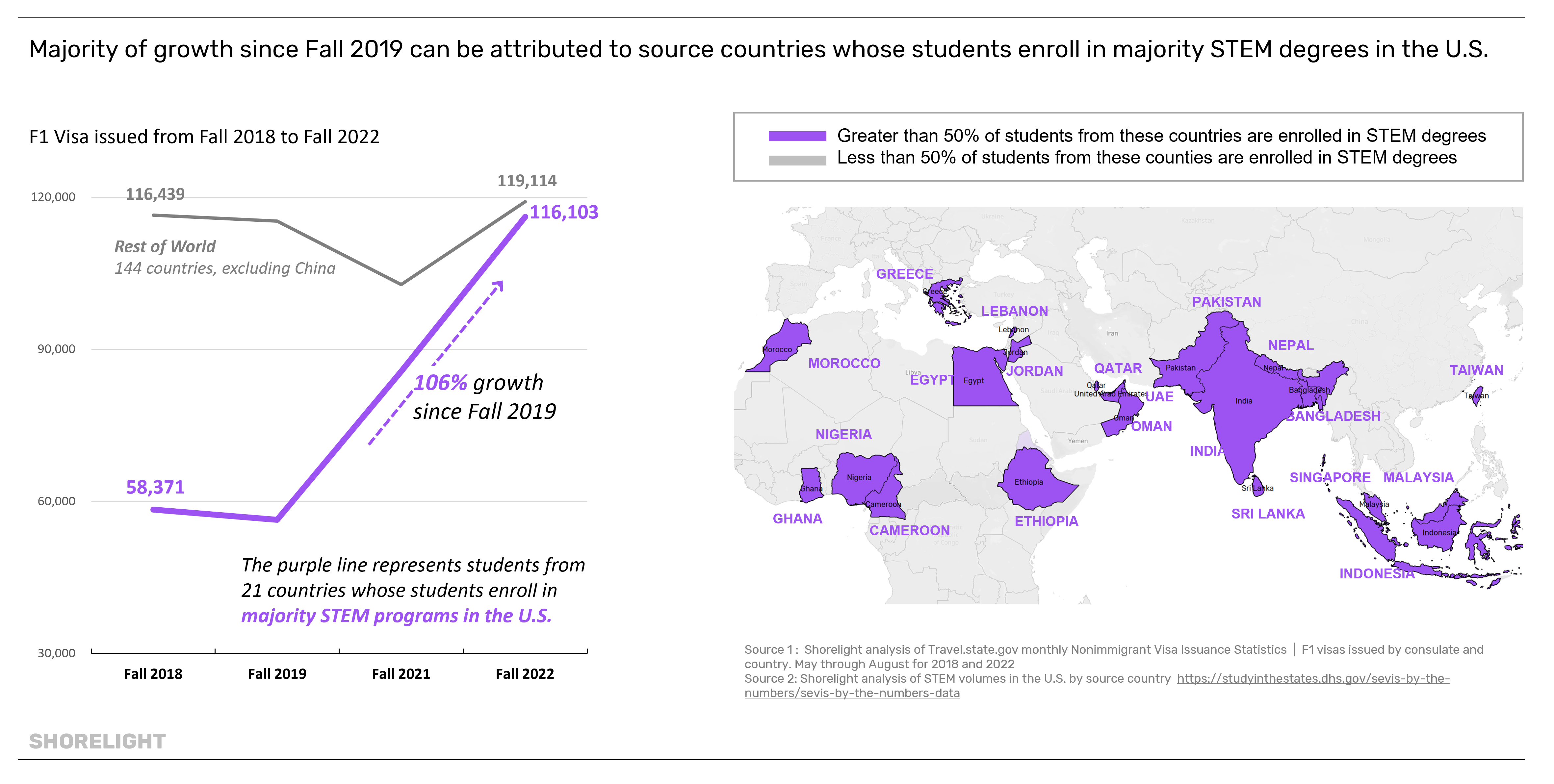Every year, millions of young people worldwide pursue higher education opportunities outside their home countries. This internationally mobile student population collectively represents enormous economic, social, and cultural benefits for countries and institutions that can attract and retain them. International students contribute billions to our economy every year, add invaluable perspective in classrooms and communities across the country, help America remain at the forefront of innovation, and provide a bulwark against structural challenges facing the American higher education system.
The US has long recognized the need for global talent and aggressively recruited students and employees to position America as a leader in innovation and growth for decades. In recent years, other leading nations have adapted their policies to compete for the top talent globally and now rival the US as a premiere destination. Accustomed to its position as a top destination, America has not kept pace with other leading countries’ policies to recruit international students away from the US and has been slow to address barriers to obtaining a visa and opportunities to pursue practical training.
It’s past time the US recognize what is at stake: losing the global talent race, a strong workforce and economy, and the sustainability of higher education institutions. The US must establish a strategy to address the negative trends in international student enrollment by modernizing the outdated immigration system.
International Student Impact
The benefits of international students in the US are tangible. During the 2021-2022 academic year, international students contributed $33.8 billion to the US economy, according to data from NAFSA. That figure is down from a high of $42.4 billion in the 2017-2018 academic year. Additionally, NAFSA data shows international students support 355,000 jobs which is also down from a high of 450,000 jobs in the 2018-2019 academic year.
Along with contributing to the overall health of our national and state-level economies, the revenue generated by international students is essential to the financial security and stability of the US institutions at which these students study. In the 2021/2022 school year, international students made up 4.7% of all students in higher education, according to Open Doors data. The disproportionate tuition payments made by international students are effectively subsidizing financial aid and other benefits extended to domestic students. Rather than taking seats away from domestic students, international student enrollment makes higher education more accessible to students in the US. As the higher education industry grapples with nearly a decade of declining enrollment among domestic students and a potentially even more severe “enrollment cliff” by 2025 – the importance of international students to the financial stability of individual colleges and universities is only magnified.

Data Source: National Student Clearinghouse Research Center
Beyond the more tangible benefits, international students bring diverse perspectives into the classroom and prepare domestic students to thrive in a global economy. Providing students with experiences outside a textbook, such as exposure to cultures with different styles of learning or communication, foreign affairs, and other cross-cultural experiences, only enhances their education and potentially creates lifelong connections that will benefit them in their future careers.
International Students and STEM
As the US grapples with a shortage of workers to fill STEM jobs, international students could fill critical jobs and keep America at the forefront of innovation. It is estimated that the US will need to fill over 3 million STEM jobs by 2025. Thousands of international students graduate each year with advanced STEM degrees and seek opportunities to gain post-graduation experience in the US. While there are some pathways for international students to apply their US education upon graduation, current policies fail to meet the high demand, and US companies lose out on employing the world’s top talent. The US must improve mechanisms to retain talented international students or risk American innovation.
Expanding opportunities in STEM would also support efforts to recruit international students to US institutions. Half of all international students in the US are enrolled in STEM programs, and Shorelight data show the ability to enroll in a STEM program is one primary factor international students consider when deciding where to study abroad. Among Indian students studying in the US, 86% are enrolled in a STEM degree program, according to our analysis of SEVIS data from May 2022.
Further research by the Shorelight Data and Analytics team shows that demand for STEM is driving growth. Since 2019, the 21 countries that sent more students to STEM programs than to other degree programs are growing much faster than other countries.
Instead of requiring US-educated students to return home, Congress should address visa barriers and limitations on OPT to ensure talented international students can stay and work beyond graduation and help the US retain and fill critical jobs. The US can remain a leader in the global talent race if we can continue to compete for and retain international students.

Maintaining The #1 Spot:
Looking ahead to 2030, experts anticipate the international student market will grow from 4 million to almost 8 million students. According to Shorelight data, the US is the only country capable of taking on the world’s higher education challenges. The US has more world-ranked universities than the 12 most populous countries combined. Despite capacity limitations, parents of the 700 million college-aged citizens in those countries seek a high-quality education for their children. For the majority, the US is their top destination. However, if the US will attract more international students, we must understand what’s driving international student demand and update policies to remain a top destination.

Data Source: OECD
In the face of fierce global competition, US domestic conditions and policies are causing more and more international students to consider other countries. The United States can no longer rely on our legacy as a leader in higher education to attract international students who are so critical to our nation’s economic, social, and cultural vibrancy.
Specific policy changes are required to reverse the current downward trends in higher education and international student enrollment in the US and provide international students an on-ramp to the American economy. An intentional effort that brings together leaders from politics, higher education, business, and elsewhere – would change the perception of America and make our nation an attractive and supportive destination for international students.
Policy Solutions: Shorelight joins others in calling on lawmakers to take action
Legislate and extend Optional Practical Training for all classifications to three years and four years for STEM fields
The ability to gain experience in their field post-graduation is one of the primary factors international students consider when deciding where to study abroad. International students can gain experiential training in the US through the Optional Practical Training (OPT) program. Under current OPT rules, students in non-STEM fields can participate in one year of OPT, while students in STEM fields are permitted to stay for up to three years.
Shorelight supports efforts to codify OPT and Curricular Practical Training (CPT) through legislation and increase the OPT program incentives for international students to enroll. Instead of a potential barrier, policymakers should extend OPT to three years for all workers and four years for workers in STEM fields to ensure that all prospective students have the option for experiential training in their field of study while in the US.
Increase Levels for H1-B Visas
Federal policymakers should dramatically increase the supply of H1-B visas to provide additional incentives for international students to study in the United States and to provide a meaningful and accessible on-ramp to incorporate these students into the American economy after graduation.
“The current imbalance in the supply of visas versus demand comes at a price for future economic growth.” Quoting the Wall Street Journal, GMAC writes, “There are tangible costs to the US economy of allocating far fewer skilled-immigrant visas than companies need. Most immediately, the cost is foregone jobs. Over the long run, the cost is foregone ideas, innovation, and connections to the world.”
Develop a concerted, cross-cutting national strategy for attracting international students and increasing the US’s share of the addressable market
Even as we promote the impact of expanding and extending visa programs, we must also acknowledge the systemic and cultural challenges facing efforts to attract and retain international students. The United States should be following the lead of nations like the UK, Australia, Canada, and India, which are creating cross-sector strategies to grow their international student populations by engaging leaders in higher education, politics, and business to create powerful incentives for international students to study here and provide ongoing support during their education and employment.
Leaders in higher education, business, and politics must be intentional and forceful in making a case for the positive impact of international students. As other nations increasingly provide more accessible, affordable, and welcoming entry into higher education and the world economy, the strength of America’s leading institutions and our historical position as a superpower are no longer enough to ensure that we remain the preeminent destination for international students. With an intentional, collaborative effort to create the policy conditions and social environment that provide international students with opportunities to study in the US, we can protect our higher education institutions, our economy, and our standing on the world stage.
Others Calling For Action:
Shorelight isn’t alone in its call to action. Many in the education and business sectors are urging Congress to protect and improve the policies that impact international students. Below are examples of organizations urging lawmakers to address the vital issue of a coordinated effort to ensure the US remains a leader in international education.
Retaining US International Student Graduates Could Help the U.S. Win the Global Talent Race
Losing Talent: An Economic and Foreign Policy Risk America Can't Ignore
Early Warning Signals Winners and Losers in the Global Race for Talent
International Students and Graduates in the United States: 5 Things to Know

